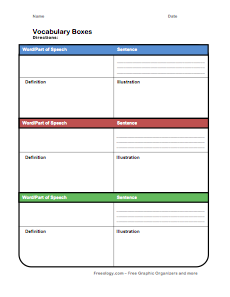Join a global community of over 200,000 TEFL teachers working throughout the world!
Enrol me!
Date Posted: 7th January 2019
Sometimes it’s the simple things that are the most effective.
If you’re a parent or a caregiver, you probably know this is especially true when it comes to children. Sometimes we spend so much time and money looking for the perfect toy or activity when there is a perfectly good free option right in front of our eyes.
Take, for example, a box. A simple box can be so many different things: a house, a canvas, a car – you name it, a box can be it. Big or small, brown or colourful – it really doesn’t matter because it can accomplish the same purpose regardless of what it looks like. And you can probably find a box lying around in your house without spending a penny.
The same can be said for the EFL classroom. We don’t always need to think of extravagant activities or games to teach language. Sometimes the simple things can be just as effective.
Which brings us back to the humble box.
Boxes can be just as useful in the EFL classroom. A box can be used for storage, as part of a game, or as a prop. There is no need to spend your money on plastic containers or Tupperware – there are probably a few paper boxes lying around the staff room that you can use for whichever purpose you need it.
And one of the most popular uses for boxes in the classroom is as vocabulary boxes.
Why are vocabulary boxes a good idea?
Words are the foundations of a language. As long as we have the vocabulary, we are able to communicate – even without grammar – but without vocabulary, we will have nothing to say. This is why learning vocabulary is important when learning a language, and consequently when we are teaching a language.
There are a number of effective strategies we can use when it comes to teaching and learning vocabulary.
Firstly, learners must see the vocabulary item in use in a natural context. They must understand the form of the word (how it is spelled), the meaning of the word, and its pronunciation. Then, they should write the word down. This can be in a vocabulary list or in a drawing – any way that suits the learner. Learners should further make associations with the word to help them remember it, use it numerous times in various contexts, and be tested on it.
Read more: Tips for Teaching Vocabulary
You might be aware that a speaker has two types of vocabulary knowledge: their passive vocabulary and their active vocabulary. Passive vocabulary is the vocabulary that you know and understand when you see or hear it but you don’t use it in your own language production. In contrast, your active vocabulary is the vocabulary that you understand and use. The aim of language learning is to move vocabulary items from our passive vocabulary to our active vocabulary.
In essence, vocabulary items need to be learned and used regularly in order to become part of a learner’s language. And this is where a vocabulary box comes in handy.
What is a vocabulary box?
A vocabulary box is a box with pieces of paper in it. The box can be a shoebox or any box. It can be plain, covered in newspaper, or wrapped in pretty paper. The pieces of paper can be paper or card, but shouldn’t be too big. The pieces of paper must be two-sided.
During or after a vocabulary lesson (or any lesson which involved new vocabulary) the teacher can write one vocabulary item on each piece of paper. On the one side the word is written and on the other the definition, an example sentence with the target language missing, or even a drawing.
This can be singular vocabulary words, like dinosaur or gigantic, phrases and expressions, like bookworm and beat around the bush, or even sayings, like actions, speak louder than words.
The cards can then be used as a means of revision. The cards are taken out of the box and given to students in pairs or groups. They can then do a range of activities with the cards which will help them revise the particular language on the cards.
Vocabulary cards can be added to the box whenever necessary – at the end of a lesson, at the end of each unit in a coursebook, at the end of the week, or at the end of the term. The cards can also be written by the students instead of the teacher if the students are capable. This will add an extra level to their revision as they are essentially studying when they are writing the cards, and this activity can be utilised as a regular revision strategy.
Read more: 3 Activities for Vocabulary Retention
Activities for vocabulary boxes
- Testing: Hand out the cards to students who are grouped in pairs. Students use the cards to test each other. Either one reads the vocabulary word and the other must provide the definition or one must read the definition and the other must give the word.
- Categorisation: Students can categorise the cards into parts of speech or lexical sets. This can be done in teams or as a whole class activity.
- Revision games: Having a vocabulary box means that you have quick access to appropriate words for word games. Whether it’s Taboo, Twenty Questions, Hangman or Pictionary, you no longer need to try to remember all the words you’ve done with a class – just pick from the box! Plus it allows the students to take charge of the games themselves.
Read more: Our Favourite Vocabulary Games
Vocabulary boxes work really well if they are used regularly. Your students will become familiar with the activities and you won’t need to spend time explaining them every time. Revision should be a regular activity in the classroom to support the learning process. Having vocabulary boxes makes doing revision quick and easy with no preparation required. If you ever have a few extra minutes at the end of a lesson, vocabulary boxes will have everything you need to fill up the time.
And all you need is a box!
Sign up to our newsletter
Follow us on social networks, sign up to our e-newsletters – get the latest news and early discounts
Accreditation Partners
The TEFL Academy was the world’s first TEFL course provider to receive official recognition from government regulated awarding bodies in both the USA and UK. This means when you graduate you’ll hold a globally recognised Level 3 (120hr) Certificate or Level 5 (168hr) Diploma, meaning you can find work anywhere and apply for jobs immediately.
-
Excellent
- 4.89 Average
- 3444 Reviews
- Reviews
Free Worksheets and More Since 2001
- Graphic Organizers
- 0
This vocabulary study graphic organizer has space to write the word, the part of speech, the definition, a sentence using the word and a simple illustration to help remember the meaning.
You may also like…
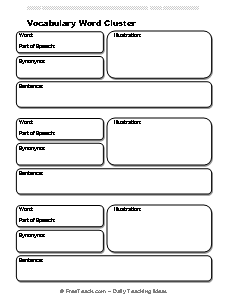
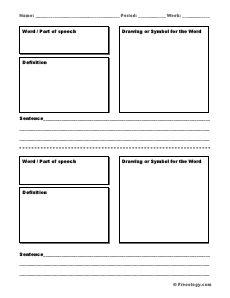
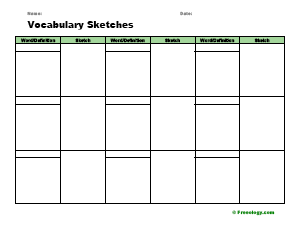
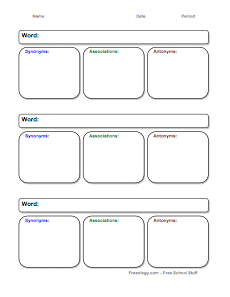
Tags: Vocabulary
- Next post Summer Journal and Coloring Page
- Previous post 14 Fun Summer Journal Topics
Menu
Pages
- About
- Privacy Policy
Categories
- Alphabet
- Articles
- Awards and Certificates
- Back to School
- Calendars
- Classroom Signs
- Coloring Pages
- Environment
- Fun and Games
- Grammar
- Graphic Organizers
- Journal Topics
- Math
- Numbers
- Poetry
- Reading
- Teacher Forms
- Telling Time
- The Lounge
- Worksheet Creator
- Writing
Follow
Follow @freeology
Coffee Fund

Feedback
This site is great! Thanks for the neat printables.
— Becky
As mentioned previously, I’m making more of a focus on vocabulary this year, and one of the things I’m going to be working with is the vocabulary box.
Now this is obviously not a new idea and it’s not even a new idea to me, I think the first time I came across this was almost exactly eight years ago in an seminar run by Bronwen Allen at IH Katowice, where she introduced the idea of wordbag cards (which is the term I’m going to use here).
Vocabulary revision and recycling is incredibly important – in “Working with Words” Gairns and Redman say that most (80%) of what we forget is forgotten within 24 hours of initial learning – clearly then it is our duty to help learners move items into long term storage and to recycle constantly.
Gairns and Redman quote Peter Russell’s “The Brain Book” as setting out the following revision schedule in order to maximise retention:
- a quick review five minutes after class
- a quick review 24 hours after class
- a further review one week later
- another review one month later
- a final review six months later
Obviously, as teachers, we aren’t always in a position to conduct all of these reviews with our learners, but we can help them out with the next best thing – the vocabulary box or the wordbag.
Here is an example of a wordbag card, bearing the school logo for a nice bit of additional branding…. To give you an idea of actual size, I have eight cards per piece of A4 paper.
It’s fairly straightforward – I have it down as “the chunk” to try and emphasise that words don’t always exist in isolation. With higher levels I try to make sure that the things that get written down are indeed chunks, with lower levels I play it by ear.
One of the problems I’ve had in the past is simply starting the wordbag off. It can be difficult for students to understand the purpose of the wordbag cards and what they are expected to do with them, you can’t always guarantee a steady stream of relevant vocabulary and it might take some time for there to be enough wordbag cards in the wordbag to actually do anything meaningful with!
So what follows is a “lesson” that I came up with this year to try and get things going. It borrows from an idea expressed in Morgan and Rinvolucri’s classically titled “Vocabulary” – namely that we have relationships with words, we have preferences and associations with them and that making use of these relationships can help the learning process.
What you need:
three wordbag cards per participant (including the teacher), already chopped up onto separate slips of paper and preferably on different coloured paper, but that’s just because it looks pretty…
Some of your favourite vocabulary games and activities (there are some ideas given below).
What you do:
On the board draw three separate three box grids, like so (only neater):
And into the top section of each grid, write a word, collocation or short phrase. I grade these according to level, so with my CAE group I might have “to insist on doing something”, but with my elementary group I might have “company car” .
The three words I used the other day were:
THEREFORE TO TOP UP FLABBERGASTED
I gave the learners two minutes to work out what connected the three items. The answer of course is that these are three of my favourite words. They are my favourite difficult word, my favourite useful word and my favourite fun / fantastic word.
I then asked learners if they knew what any of the words meant – if they came up with a suitable definition or expression of meaning, I put that in the second (middle) section. But if not, I gave them a contextual sentence and wrote it in the third (bottom) section – e.g. “I ran out of credit so I had to top up my mobile this morning.”
Eventually, you get all of the boxes filled and then I check what goes into each section and label the sections with “the chunk”, “meaning” and “example sentence”.
I then asked all the learners to think of their favourite difficult, useful and fun/fantastic words and note them down.
One problem I’ve had with this stage is duplication of items, particularly if the learners are struggling to think of something suitable and overhear their colleagues coming up with a good idea. So I’ve done this on a “first come first served” basis, making clear there should be no duplication and writing up the words the learners choose on the board next to their names.
Once everyone (or most of the class) have got their three words, I give out some wordbag cards and the learners fill them in. For the fast finishers, the answer is simple – just give them another wordbag card and tell them to add another item to the mix!
So by the end of this stage you should have at least three times as many wordbag cards as learners and can then finish off the class by doing a number of different vocabulary based activities with the learners, using their new wordbag cards.
With any luck, by the end of the lesson, the class will understand what a wordbag card is, what should go on it and how it’s going to be used in classes. They’ll have a basis for ongoing additions to the wordbag, plus a foundation for future revision / recycling activities at the start of end of the class – and it gives the teacher a chance to hit the ground running with the wordbag so that you don’t lose momentum while trying to build up a sufficient stock of cards in the wordbag.
1. Word Wall
To help your students get more engaged in vocabulary development, you need to nurture word consciousness. This means raising students’ awareness of, and interest in all sorts of words and their meanings.
A Word Wall can help you achieve this. This is a collection of words that are displayed in large visible letters on a wall, bulletin board, or other display surfaces in a classroom.
Source: ELL STRATEGIES & MISCONCEPTIONS
So, set this wall and encourage your students ‘to walk the wall’ and hang their favourite words, new or unknown, on it.
Then, invite their classmates to add sticky notes with pictures or graphics, synonyms, antonyms, or related words. Then, student partners walk along the wall to quiz each other on the words (Graves & Watts-Taffe,2008).
Use the Word Wall one or more times a week. You’ll help your students make connections between new and known words.
Since this is an ongoing activity during the whole year, you can keep observational notes of those students who are posting, responding to their words and those who are not adding words to the wall.
This will help you better understand what your students need to expand their vocabulary.
2. Word Box
Word Box is one of the strategies for teaching vocabulary. This is a weekly strategy that can help students retain and use words more effectively.
Students select words to submit to the word box on Friday. These are words they find interesting or ones they want to understand better. They either use the word in their own sentence or take the same sentence where this word was found.
Then, select five words to teach the following week.
Monday: Introduce the five words in context, explain them, then tack them to the Word Wall.
Tuesday: Ask students to create a non-linguistic representation of the words.
Wednesday: Discuss the meaning of the words allowing think-pair-shares.
Thursday: Ask students to write sentences using those words.
Friday: This is the day to assess students’ learning of the five words using this activity.
Ask one student to answer fill-ins for five words. Give students three cards that can hold up: green cards show they agree with the student’s answer, yellow they are unsure and red ones they disagree.
For assessing, use a checklist with the vocabulary running horizontally across the top margin and the class list running vertically down the side. (Adapted from Grant et al., 2015, p.195)
3. Vocabulary Notebooks
Ask your students to maintain vocabulary notebooks throughout the year where they write the meaning of the new words.
You can introduce a new word each week and work together with students to explore its meaning. Then, ask them to sketch a picture to illustrate the word and present their drawings to the class at the end of the week.
Another way to use vocabulary notebooks :
Students create a chart. The first column indicates the word, where it was found, and the sample sentence in which it appeared.
The other columns depend on your students’ needs.
You can include a column for meaning ( where students define the word or add a synonym), for word parts and related word forms (where they identify the parts and list any other words related to it), a picture, other occurrences (if they have seen or heard this word before, they describe where) and for practice or how they used this word. (Lubliner, 2005)
4. Semantic Mapping
These are maps or webs of words that can help visually display the meaning-based connections between a word or phrase and a set of related words or concepts.
Teach your students how to use semantic mapping. Pick a word you intend to explain, draw a map or web on the board ( or on Zoom whiteboard or any digital tool in case you’re teaching online) and put this word in the centre of the map. Then, ask students to add related words or phrases similar in meaning to the new word. (see the example below)
Source:weebly.com
5. Word Cards
Word cards can help students review frequently learned words and so improve retention.
On one side of the card, students write the target word and its part of speech (whether it’s a verb, noun, adjective, etc.).
On the top half of the other side, they write the word’s definition (in English and/ or a translation). They also write an example and a description of its pronunciation. The bottom half of the card can be used for additional notes once they start using the word.
Ask students to add more information about the word each time they practise or observe it (sentences, collocations, etc.).
Yet, advise them not to add too much information in order to facilitate more reviewing the cards.
Devote regularly class time for students to bring their word cards to class. Involve them in activities such as describing the new words, quizzing one another, categorizing them according to subject or part of speech.
Also, show your students how to store and organize those cards. This is, for instance, by putting them into a box with the categories they select or ordering them in terms of difficulty. (Schmitt & Schmitt, 2005)
6. Word Learning Strategies
Our students often have only partial knowledge of the words they learn in the classroom. This is so since a word can have different meanings which they may not be familiar with.
Therefore, teaching students word learning strategies is important to help them become independent word learners. This is by teaching, modelling and providing a variety of strategies that serve different purposes.
Here are some examples of word-learning strategies.
a) Using word parts
Breaking words into meaningful parts facilitates decoding. So, studying words’ parts can help students guess the meaning of new words from context.
There are three basic ways that word parts are combined in English: prefixing, suffixing, and compounding.
Teach those parts. But, focus on the most occurrent ones.
Providing explanations about their use and meanings with illustration is necessary. Yet, it is still not enough.
You need to provide opportunities for students to experiment with word-building skills.
For instance, you can hand out a list of productive prefixes and have students compile a list of words using them. Then, ask them to compare the function of the prefixes in the various examples.
However, consider your students’ level since word parts are more useful to students with larger vocabularies. For instance, a student who doesn’t know the meaning of the adjective content cannot guess the word discontent.
Remember also that learning word parts is an ongoing process. So, encourage your students to continue experimenting with them. (Zimmerman, 2009a)
b) Asking questions about word
Knowing a word means knowing about its many aspects: its meaning(s), collocations, grammatical function, derivations, and register.
So, you can encourage your students to explore a new word’s meaning(s) by asking them to address detailed questions about those features and answer them.
Students will ask questions like these :
• Are there certain words that often occur before or after the word ? (collocation)
• Are there any grammatical patterns that occur with the word ? (grammar).
• Are there any familiar roots or affixes for this word ? (word parts)
• Is the word used by both men and women? (register/appropriateness)
• Is the word used in both speaking and writing?
(register/appropriateness)
• Could it be used to refer to people? Animals?Things? (meaning)
• Does it have any positive or negative connotations? (meaning) (Zimmerman,2009a)
c) Reflecting
When students learn new words it does not necessarily mean they’ll use them. Students may avoid using words in writing because they are unsure of the spelling. When they speak, they may not be willing to use certain words as they roughly understand them in context.
Encouraging students to self-assess their knowledge of each new word they learn can help them focus on areas needing practices. Here is an example of a self-assessment scale students can use.
Besides these 6 engaging strategies for teaching vocabulary, here are some essential tips to follow while using them :
1) Identify the potential list of words to be taught. Keep the number of words to a minimum (three to five words in one lesson) to ensure there is ample time for in-depth vocabulary instruction, yet enough time for students to practise them.
2) Expose students to multiple contexts in which the new words can be used. This will support them to develop a deeper understanding of these words and how they’re used flexibly.
You can do so by giving students frequent opportunities to hear the meaning of the words, read content where these words are included, and also use them in speaking and writing.
3) Encourage extensive reading because this gives students repeated or multiple exposures to words and is also one of the means by which students see vocabulary in rich contexts.
So, for rich vocabulary development, use a variety of strategies for teaching vocabulary and provide the necessary support and guided practice. Besides, assess vocabulary learning and encourage students to learn more words outside the classroom.
What other Strategies For Teaching Vocabulary would you suggest? I would love to hear from you.
References
Grant, K..B., Golden, S.E., & Wilson, N.S.(2015). Literacy Assessment and Instructional Strategies: Connecting to the Common Core. USA: Sage Publications, Inc.
Graves, M.F., & Watts-Taffe, S.M. (2002). The place of word consciousness in a research-based vocabulary program. In A.E. Farstrup 1 S.J.Samuels (Eds.), what research has to say about reading instruction (3rd ed., pp.140-165). Newark, DE: International Reading Association.
Graves, M.F., & Watts-Taffe, S.M. (2008). For the love of words: Fostering word consciousness in young readers. The Reading Teacher, 62 (3), 185-193.
Hulstijn, J. & Laufer, B.(2001). Some empirical evidence for the involvement load hypothesis in vocabulary acquisition. Language Learning 51/3:539-58.
Lubliner, SH.(2005). Getting into Words: Vocabulary Instruction That Strengthens Comprehension. Baltimore: Paul H. Brooks Publishing.
Schmitt, D., & Schmitt, N.(2005). Focus on Vocabulary. New York: Longman.
Zimmerman, Cheryl. B.(2009a). Word Knowledge: A vocabulary teacher’s handbook. New York: Oxford University Press.
Zimmerman, Cheryl. B.(2009b).(ed.). Inside Reading: The Academic Word List in Context. Four Levels. New York: Oxford University Press.
- Home
-
Documents
- Vocabulary Work and Study
-
Author
-
View
227 -
Download
0
Embed Size (px)
DESCRIPTION
pikm


